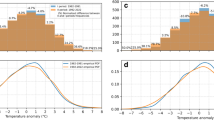Abstract
Surface air temperature (SAT) is a key meteorological parameter. Modelling and forecasting of the SAT has vital importance to understand the ecological and agricultural changes. We utilized all India monthly mean SAT, which covers a time span of 1951–2016. We used structural time series (STS) analysis to model and forecast the monthly mean SAT. Forecast during 2006–2016 well matched with the observational data. Further, the forecast of monthly mean surface air temperature patterns for 2017–2019 shows a good agreement with climatological behaviour. Note that we observed an increasing trend 0.0009°C per year in monthly mean surface air. Further, we noticed slight chance of rise in temperature about 0.1°C specially for the months of April, May and December in the years 2017–2019.
Highlights
-
An increasing trend of 0.0009oC per year is evident in the monthly mean surface air.
-
Raise in temperature of 0.1oC is evident during April, May and December.











Similar content being viewed by others
References
Box G E P, Jenkins G M and Reinsel G C 1994 Time Series Analysis: Forecasting and Control; 3rd edn, Prentice Hall, New Jersey.
Cryer J D and Chan K S 2008 Time Series Analysis with Application in R; 2nd edn, Springer, New York.
Enakshi S, Arnab H and Pabitra B 2016 SARIMA modeling of the monthly average maximum and minimum temperatures in the eastern plateau region of India; Mausam 67(4) 841–848.
Foster G and Rahmstorf S 2011 Global temperature evolution 1979–2010; Environ. Res. Lett. 6 044022, https://doi.org/10.1088/1748-9326/6/4/044022.
Harvey A C 2001 Forecasting, Structural Time Series Models and the Kalman Filter; Cambridge Univ. Press, UK.
IPCC: Climate Change 2013 The physical science basis; Contribution of Working Group I to the Fifth Assessment Report of the Intergovernmental Panel on Climate Change.
Kaipa Viswanath N M and Ramachandran S 2019 Unobservable components modelling of monthly average maximum and minimum temperature patterns in India 1981–2015. Pure Appl. Geophys. 176(1) 463–482, https://doi.org/10.1007/s00024-018-1970-2.
Keller C F 2009 Global warming: A review of this mostly settled issue; Stoch. Environ. Res. Risk A. 23 643–676.
Mikkonen S, Laine M, Makela H M, Gregow H, Tuomenvirta H, Lahtinen M and Laaksonen A 2015 Trends in the average temperature in Finland, 1847–2013; Stoch. Environ. Res. Risk A. 29 1521–1529, https://doi.org/10.1007/s00477-014-0992-2.
Murthy K V N and Kishore Kumar G 2020 Structural time-series modelling for seasonal surface air temperature patterns in India 1951–2016; Meteorol. Atmos. Phys., https://doi.org/10.1007/s00703-020-00732-7.
Narasimha Murthy K V, Saravana R and Vijaya Kumar K 2018 Modeling and forecasting rainfall patterns of southwest monsoons in north-east India as a SARIMA process; Meteorol. Atmos. Phys. 130 99–106, https://doi.org/10.1007/s00703-017-0504-2.
Narasimha Murthy K V, Saravana R and Vijaya Kumar K 2019a Stochastic modelling of the monthly average maximum and minimum temperature patterns in India 1981–2015; Meteorol. Atmos. Phys. 131(4) 775–787, https://doi.org/10.1007/s00703-018-0606-5.
Narasimha Murthy K V, Saravana R and Rajendra P 2019b Unobserved component modeling for seasonal rainfall patterns in Rayalaseema region, India 1951–2015; Meteorol. Atmos. Phys. 131(5) 1387–1399, https://doi.org/10.1007/s00703-018-0645-y.
Narasimha Murthy K V, Saravana R and Rajendra P 2019c A UCM approach for forecasting the seasonal rainfall patterns in coastal Andhra Pradesh, India 1901–2017; Pure Appl. Geophys., https://doi.org/10.1007/s00024-019-02236-x.
SAS/ETS® 13.2 User’s Guide 2014 The UCM Procedure; SAS Institute Inc. SAS/ETS® 13.2 User’s Guide, Cary, NC: SAS Institute Inc.
Stoffer D S and Shumway R H 2010 Time Series Analysis and its Application; 3rd edn, Springer, New York, 10: 1441978658.
Srivastava A K, Rajeevan M and Kshirsagar S R 2009 Development of a high resolution daily gridded temperature data set (1969–2005) for the Indian region; Atmos. Sci. Lett. 10(4) 249–254.
Viswanath N M K, Ramachandran S and Reganti H R 2020 Modeling and predicting the patterns of seasonal rainfall in Tamil Nadu, India 1951–2017: An UCM approach; Arab. J. Geosci. 13 226–236, https://doi.org/10.1007/s12517-020-5216-0.
West M and Harrision J 1999 Bayesian Forecasting and Dynamic Models, 2nd edn, New York; Springer-Verlag.
Wu W B and Zhao Z 2007 Inference of trends in time series; J. Roy. Stat. Soc. B. 69 391–410, https://doi.org/10.1111/j.1467-9868.2007.00594.x.
Young P C 2011 Unobserved component models; In: Recursive Estimation and Time-Series Analysis; Springer, Berlin, Heidelberg, https://doi.org/10.1007/978-3-642-21981-8_5.
Acknowledgements
We gratefully acknowledge the India Meteorological Department (IMD) for providing the monthly mean temperature data through Open Government Data (OGD) Platform, India. The authors are thankful for the worthwhile comments of the reviewers, which led to definite improvement in the paper.
Author information
Authors and Affiliations
Contributions
KVNM proposed the paper, produced most of the material and wrote the manuscript. RS and KVK helped in formulating the part of methodology and data analysis. GKK helped to formulate some of part of the methodology and to bring the scientific interpretation of the results. All authors discussed the results and reviewed the writing.
Corresponding author
Additional information
Communicated by Kavirajan Rajendran
Rights and permissions
About this article
Cite this article
Narasimha Murthy, K.V., Saravana, R., Kishore Kumar, G. et al. Modelling and forecasting for monthly surface air temperature patterns in India, 1951–2016: Structural time series approach. J Earth Syst Sci 130, 21 (2021). https://doi.org/10.1007/s12040-020-01521-x
Received:
Revised:
Accepted:
Published:
DOI: https://doi.org/10.1007/s12040-020-01521-x




